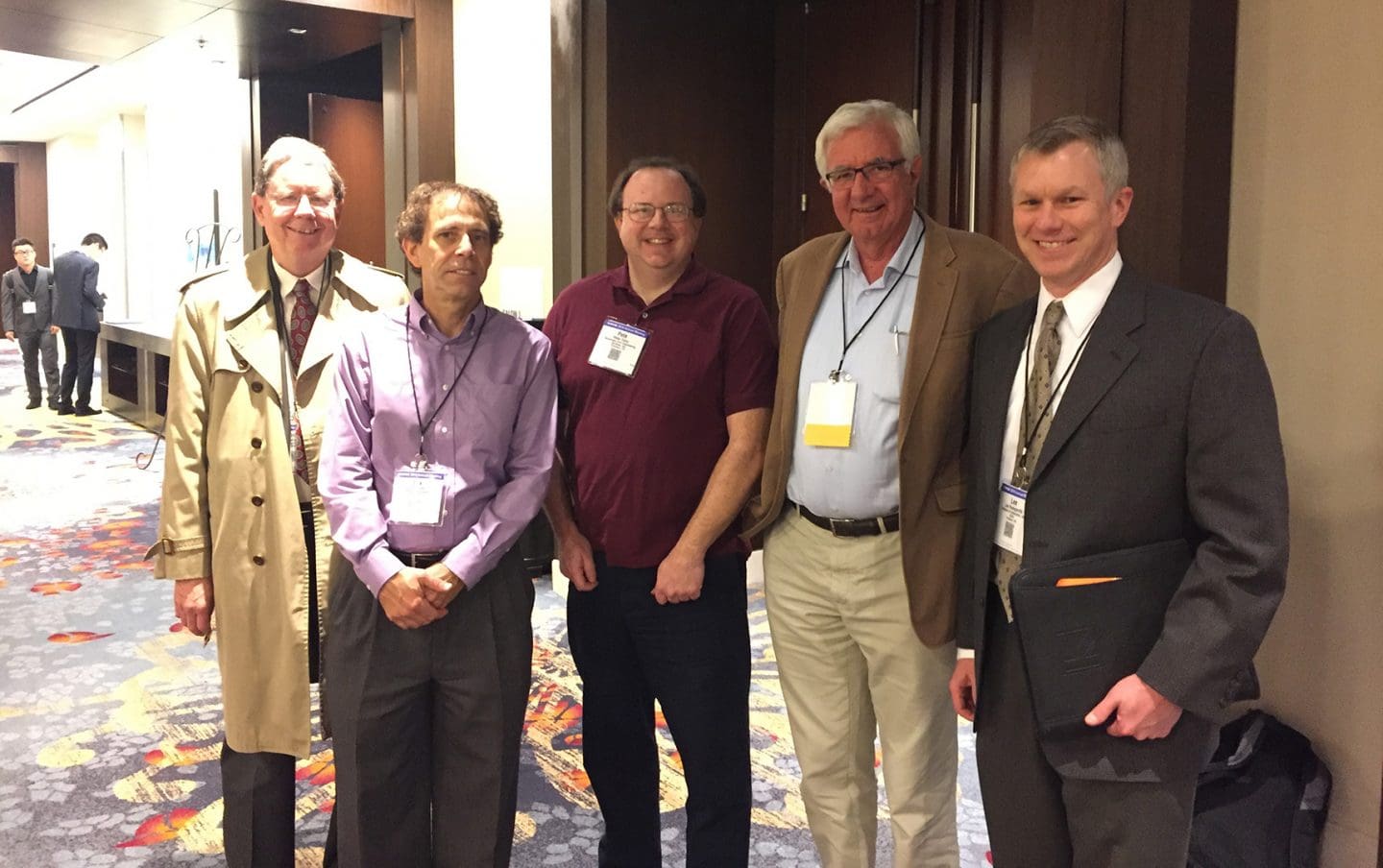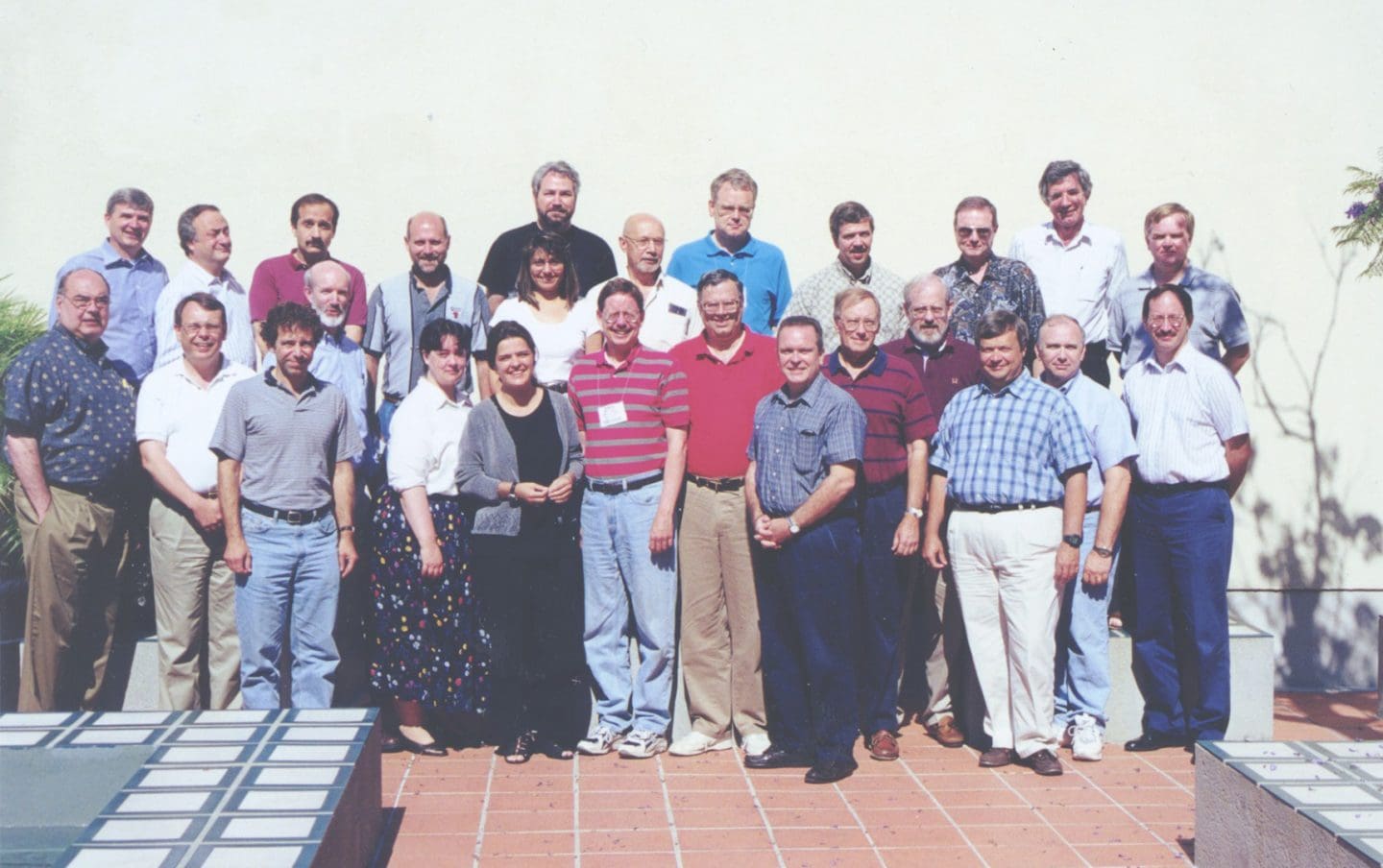August 18, 2020
In an age of reliance on software programs, Michael Kyte and Rod Troutbeck’s Traffic Operations at Intersections is designed to help practitioners better understand and apply the methodologies of the Highway Capacity Manual.
“Learning from the Highway Capacity Manual (HCM) is a real challenge,” said Michael Kyte, Emeritus Professor of Civil Engineering at the University of Idaho.
In a virtual meeting over Microsoft Teams, five professionals – Michael Kyte, Rod Troutbeck, Wayne Kittelson, Julia Kuhn, and Lee Rodegerdts – were gathered to talk about why Michael and Rod saw the need to write a book to make the HCM more accessible to transportation practitioners and professors.
Michael’s statement comes from decades of learning and applying the HCM, including 30 years of teaching civil engineering after working as a transportation engineering consultant himself. And looking at the sixth edition of the Highway Capacity Manual, it’s understandable.
Compared to the 147-page first edition, which was published in 1950, the sixth edition is a four-volume manual with more than 2,000 pages containing a plethora of complex methodologies across a full spectrum of facility types. As Lee Rodegerdts, Principal Engineer at Kittelson, said: “The manual has gotten so complex to the point no one knows what’s in it.”
As lead authors of the HCM2010 and the HCM 6th Edition, Kittelson understands firsthand that the added complexity is a direct result of several decades and multi-million dollars’ worth of national research, and is reflective of an ever-increasing expansion of the knowledge base in our industry. While the 1950s manual was able to cover the basics in 150 pages, we now tackle far-ranging topics from multimodal quality of service to Transportation Management and Systems Operations (TSMO) strategies, to whole-year reliability analysis in a much more comprehensive manual. The Highway Capacity Manual is one of the essential guides of the transportation profession that provides methods for quantifying capacity and evaluating the multimodal operation of highways and streets.
However, most transportation engineers and planners rely on software to conduct their analyses and may not even pick up the manual.
Seeing the need to bring a working knowledge of the HCM to the next generation of transportation professionals, Michael Kyte and Rod Troutbeck have spent the last five years developing a resource that may help engineers and planners better understand what’s inside it.
Learning Concepts, Not Software, First
“We tend to start by teaching young professionals the software – here is how to use a specific tool – but this doesn’t give the young professional a critical understanding of, “ËœWhat does it mean?’ to be able to interpret and evaluate it to judge if it’s correct or not,” said Wayne Kittelson, Senior Principal Engineer at Kittelson, in a reflection of how interns and transportation analysts are often trained in their first few months on the job.
While learning the software is a practical skill, practitioners are done a disservice to not also learn the concepts behind the outputs so they can determine if the outputs are reasonable and how they fit into the bigger picture.
Why is understanding the methodologies so important?
“The thing that I apply every single day, that I learned from Mike, is to be able to step back and look at things and say, “ËœDoes what this computer model is telling me make sense? Does it seem reasonable?'” said Senior Principal Engineer Julia Kuhn. “We can model the heck out of stuff, but how does it help us further our understanding to either verify or question what we’re finding and how we use the information?”
Being familiar with the HCM also makes it possible for it to be applied in new ways. “Once you understand the basics, it’s about new application – how do we make it work for bicycles and pedestrians? Connected and automated vehicles? Once you understand the basics, you can build on these other things,” said Lee.
Finally, a working knowledge of HCM concepts is critical for troubleshooting complicated intersections.
“Everybody can handle the easy intersections. It’s the tough ones where it’s not modeling the way you think it should, and you need to change something but don’t know how,” described Lee Rodegerdts. “I usually get pulled into those discussions because I have a bit of understanding about what’s going on under the hood and I know which knobs to turn. But most people don’t know how to turn the knobs under the hood.”
For those situations where there isn’t an experienced practitioner like Lee available to troubleshoot – which increase in number as the industry relies more and more heavily on software applications – there’s a need for a new generation to learn the HCM, and learn it soon.
A Book Created Through Years of Teaching and Research
Even if the argument is clear for understanding HCM concepts, the challenge remains that it’s a long, complex manual that is hard to understand – which is where Michael and Rod’s book, Traffic Operations at Intersections: Learning and Applying the Models and Methods of the Highway Capacity Manual Using Simplified Scenarios and Computational Engines, enters the scene.
“I’ve always had an interest trying to understand better how people learn,” said Michael in describing how Traffic Operations at Intersections came about. “I wanted to understand how to make complex ideas simple enough so that I could understand and teach them to students. The book comes from years of teaching and research of how one presents things in a simplified way.”
In addition to his roles working for the public transit system in Portland, OR, as a transportation engineering consultant, and teaching civil engineering at the University of Idaho, Michael was a member of the Transportation Research Board’s Committee on Highway Capacity and Quality of Service for many years and has a longstanding history with Kittelson & Associates, including collaborating on research projects and serving as a mentor for several of Kittelson’s senior leadership team members who connected with him at the University of Idaho.
“To me, Mike was really truly the first person in this profession who took a genuine interest in my development, took me under his wing,” said Julia. “He really provided a personal connection and I continued for many years to go back to him if I needed to ask a question.”
Michael wrote the book in partnership with Rod Troutbeck, a principal of Troutbeck & Associates, an Emeritus Professor of Civil Engineering at Queensland University of Technology, and an Adjunct Professor with the QUT Centre for Accident Research and Road Safety (CARRS-Q). Rod has also been connected to Kittelson & Associates for many years, beginning with a meeting at TRB.
“Mark Vandehey and I were presenting a research paper on what we’d found on critical gap analysis,” remembered Wayne. “Then came along a guy who knew a lot more about it than we did in the form of Rod Troutbeck. He started doing some of the mathematical introductions of maximum likelihood theory and how critical gaps were developed in the first place. I may even still have some of those notes. That was really where Rod became integral and connected to us.”
“A number of us could call ourselves students of Rod Troutbeck over the years,” added Michael, referring to Rod’s passion for training up the next generation.
“We go back such a long time, all of us really. I don’t know whether you remember that it was 21 years ago that I was at a Kittelson office,” said Rod, referencing the sabbatical he spent at Kittelson’s Portland office.
“What I’ve done is really to support Mike in this exercise,” he continued. “The way you lay it out, the way you give information to people, that’s Mike. And that’s really the crux of the matter is getting students to appreciate the information and understand how they can put it together.”

A gathering at the 2016 TRB Annual Meeting of five current or past chairs of the HCQS Unsignalized Intersections Subcommittee. Left to right: Michael Kyte, Erik Ruehr, Peter Terry, Rod Troutbeck, Lee Rodegerdts.

Group photo taken in the summer of 1999 at TRB's Beckman Center in Irvine, CA, following the Committee's summer meeting that resulted in the final approvals necessary for publication of HCM2000. Wayne Kittelson is in the back left, Michael Kyte is in the front row (6th from the left), and Rod Troutbeck is in the back row (2nd from the right).
Explaining Complex Concepts With Simplified Scenarios
Traffic Operations at Intersections isn’t a textbook, per se – it is a supplement to the HCM meant to introduce readers to the fundamentals. Rather than asking a transportation analyst to dig into the four-volume HCM itself, this book breaks down the concepts, starting with simple building blocks. It is focused on signalized and stop-controlled intersections as two important components of the HCM, but also leaves out other topics like roundabouts, multimodal analysis, and freeway operations that are covered elsewhere.
Michael and Rod use a phrase called the “simplified scenario.” The book is built around eleven scenarios that are based on conditions greatly simplified from what you would normally see in the field. By focusing on one concept at a time, in the context of these simplified conditions, readers can better understand the fundamentals of the HCM intersection models.
“That’s something I learned from these two guys,” said Lee. “You’ve still got to come back to these basic building blocks and incrementally add to them one at a time. This is the concept behind the book that’s really important.”
“The other part about all of this is understanding we don’t know all there is to know about these processes,” said Rod. “What we’re trying to do is get a better and better model. But in that process we’ve got to be careful we don’t lose sight that better models might not be better, they might just have more inputs. That’s something this book is about, to try and make sure that you’ve got simple processes. Simple models can be of great assistance.”
He added, “Once you know what’s behind it, gee, it makes a difference to what you can do.”
Who Will Get the Most Value Out of Traffic Operations at Intersections?
Michael and Rod see value for both practitioners and the academic world.
For all the reasons described above, young transportation engineers as well as mid- and senior-level practitioners will be more effective in applying and troubleshooting outputs from software models with a working knowledge of what’s “under the hood.” The knowledge is relevant to transportation planners, too. Julia, whose work is primarily focused on planning and development services, said, “There is rarely a day that goes by I don’t look at something from an intersection operational standpoint. This cuts across my planning work – for an environmental document or a 20-year plan for a city – and my development services work, where one of the criteria and codes we adhere to is, ‘Can the transportation system accommodate what our client wants to do?’ So absolutely we are using the HCM every day, day in and day out.”
The book may be of value to professors, too. “I know that I’ve talked to several professors around the country who said they used to teach courses that involved the HCM and they really can’t anymore because it’s gotten too complex,” said Michael. Breaking down the complex methodologies through simplified scenarios benefits teachers as well as students, and makes it more possible for the knowledge to be perpetuated.
“I’m hoping for practitioners, for students, for instructors, dealing with simplified scenarios allows someone to get to the ending point of understanding.”

Transportation practitioners will be more effective in applying and troubleshooting outputs from software models with a working knowledge of what's "under the hood" of the Highway Capacity Manual.
Seeing the Relevance of the Highway Capacity Manual in an Age of Software Programs
Tyrone Scorsone is a senior planner in Kittelson’s Tallahassee office. When asked about the relevance of the HCM in his planning work, he noted it has tremendous value.
“I use the HCM with constant regularity as a resource,” said Tyrone. “I do agree that it’s easier to use the software and plug in the inputs rather than doing manual calculations. But the HCM is a guiding resource for tons of other things beyond just calculations. Understanding the nuances of a left turn – how many vehicles should we expect will hang out in that left turn area? We can guess at it, scratch our heads, or go to the HCM and get the definite answer.”
Traffic Operations at Intersections is a resource that presents two unique opportunities for the industry: it could serve as a model for future resources that help practitioners understand the manuals and guidebooks, and it could make it possible for a new generation of transportation professionals to confidently understand and apply one of the most powerful predictive tools in our profession.
Principal Engineer Bastian Schroeder, who is also a member of the TRB Committee on Highway Capacity and Quality of Service, is excited for the ways Michael and Rod’s book complements the HCM: “Counter-balancing the added complexity of the HCM with a back-to-the-basics how-to-guide to intersection analysis is incredibly timely and relevant for our industry.”
The conversation over Microsoft Teams was also a reconvening of colleagues and friends who have supported each other’s careers in tremendous ways.
“I’ve thoroughly enjoyed having access to you, Wayne, Mike, Julia, Lee. You learn a lot from everyone else,” said Rod. “No one knows more than anyone else, really. We just all know different things. And it’s when you can put those different things together to make something really positive, I think that’s great.”
“We can all feel we’ve done some interesting things over our career, but the people who make that possible and give us ideas and room to work and support – it’s important,” said Michael. “I want to give Wayne a personal thanks over the years to helping me develop to my fullest.”
Rod added, “Kittelson has been behind the HCM and the Highway Capacity Committee for as long as I can remember. Our involvement with Wayne has been one of the driving forces that have caused us to work together. And the outcome of that has been this book.”
—
For more information on Traffic Operations at Intersections, visit the book’s website.
